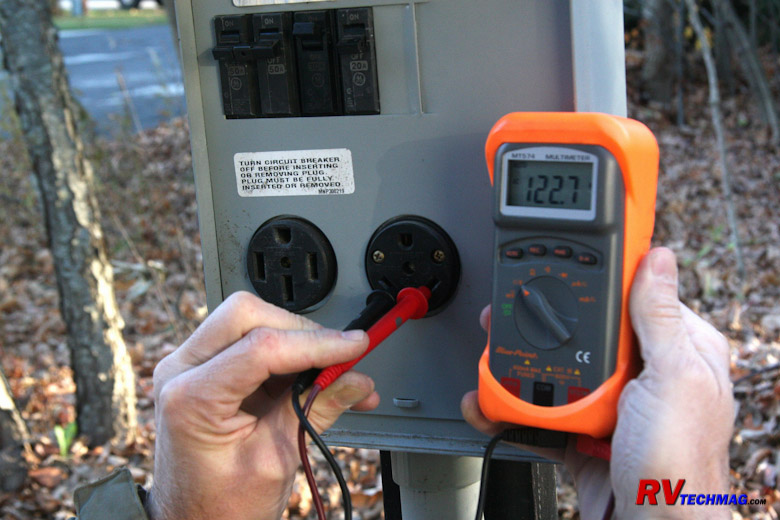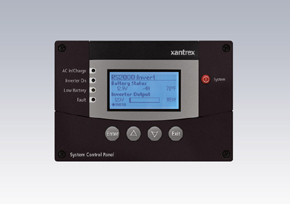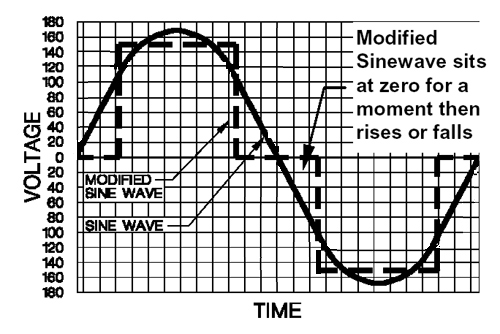|
RV Electrical Tutorial

Chapter 9 - Inverters
As we learned earlier, inverters do just the opposite of converters because the create 120 volt AC power
from 12 volt DC battery power. In actuality they don't "create" the power, they transform it electronically. An inverter uses
electronic signal processing circuitry and transformers to bump the 12 volts up to 120 volts and change the DC current into
AC current. The electronic circuitry does create the proper frequency and voltage levels that make up the waveform of the output
current so while the inverter doesn't really create power, it takes existing power and molds it into a different output. In the
process of doing so there will be a slight loss of between 6 and 15% so just because you are inputting 2,000 watts of battery power
doesn't mean you'll be getting the full 2,000 watts as output.
|

Xantrex RS3000 Inverter
|

System Control Panel
|
Inverters are available in many sizes. Inverters can be as small as 175 watts. These units can plug into a 12 volt
power socket and be used to power a small power tool. Larger inverters can be direct connected to a battery source and mounted in
an RV's cabinet to power TVs or other entertainment equipment. Some of these inverters can run 1,000 watts, or even 1,800 watts in
size. The second style is the inverter/charger. These units are larger and designed to handle multiple circuits. Inverter/Chargers
typically range from 2,000 watts to 3,000 watts in size. They also provide battery charging capability so when an inverter/charger
is used the converter is eliminated because it's no longer needed.

Modified Sine Waves versus True Sine Waves
Sine Waves:
Inverters may out put one of two waveforms. The waveform that is output by your generator set is a true sine wave.
The power put out by your public utility is also true sine wave because it too is created in a generator, even though it's a very
large one. The voltage will rise and fall like a large S-curve as the field passes by the magnets in the generator. This creates a
wave where the peak voltage appears for an instant, then falls back down to zero. However, peak voltage is meaningless. Your
equipment is designed to run on 120 volts RMS (Root Mean Square) voltage, which is the voltage level at a given width of the wave.
Voltmeters will also read RMS voltage so there's no calculations or anything complex to have to worry about.
Inverters do not have rotating parts and magnets. Instead, they create the desired waveform and frequency electronically.
The earlier inverters were known as modified sine wave inverters. The waveform created by these inverters took a straight vertical
leap to a given level, then traveled in a straight horizontal line for a given time, then fell instantly back to zero volts and rested
for a while before repeating this cycle over and over again. Unfortunately, this power can create issues with sensitive electronics
equipment and electric motors because it is not a true sine wave. A standard voltmeter will read this as a much higher voltage, probably
around 150 volts rather than 120 volts. It takes a special voltmeter to take modified sine wave readings. The biggest problem is that
electric motors and integrated circuits get messed up by this as well. But, at the time there wasn't that much high tech stuff on the
market and modified sine wave inverters were an affordable alternative
As system became more complex, so did the need for inverters with a cleaner waveform. The advent of the true sine
wave inverter gave us that ability. Fortunately, as electronics improved, so did the ability to make cost effective true sine wave
inverters. A true sine wave inverter perfectly matches utility power and there are no longer any limits to what can safely run on it.
The graph above shows the difference between the two sine waves. If you are running simple things, such as lighting, you won't really
have an issue with modified sine wave. Modified sine wave inverters will power toasters, lights, microwaves, any electrical heating
element, as well as most motor loads such as refrigerators, vacuums, etc. Electronics do not fare as well on modified sine wave. Digital
clocks will not keep accurate time. Many small battery chargers, such as used on cordless power tools will not function correctly. And
any electronic device is subject to failure. The biggest issue is that all major appliances are now becoming heavily interfaced with
electronics. While your refrigerator's compressor motor may run fine on modified sine wave, the electronic control panel in the door
that controls the water dispenser and ice maker may not like it and will fail. Microwaves ovens will function but the electronic control
panel may not hold up that long. Laptop computers will run fine because the inverter is merely powering a battery charger. The battery
itself acts as a buffer and runs the laptop on DC power, even when plugged into the AC adaptor. Desktop computers are not in the same
category though and you will probably smoke them pretty quick. Modified sine wave inverters will also generate RF noise in the line so
you will have issues if you try to power a ham radio with one. Motor speed controllers using triacs won't work properly either. If there
is a "wall wart" power supply box plugged into the wall you'll be fine though. Inkjet printer models can be either way on this so check
first. Generally, if you see the current transformer on the power supply, you'll be fine.
Inverter Operation:
A simple inverter isn't that hard to figure out. It connects to a battery power source and you plug your AC load into
the receptacle. You turn it on and it works. Larger inverter/chargers area bit more complex. An inverter/charger also has a 12 volt DC
battery input and a 120 volt AC power output. These units are larger so they are generally hard-wired into the coach's electrical
systems. The inverter also has a 120 volt AC power input connected to it as well. Inside the inverter is an automatic transfer switch to
handle switching of the inverter's AC output from between the inverter created power and the 120 volt input power. Whenever you are
plugged into shore power or the generator is running, there will be 120 volt power present at the inverter's inputs. The inverter will
simply pass that power through to the inverter's output. This is referred to as pass-through power. Whenever 120 volt AC power
is not present at the inverter's inputs the inverter will create ("invert", actually) AC power from the batteries and the transfer switch
will flip over to the inverter's own power to feed the desired devices. Because of this it is not necessary to turn the inverter off and on
because the transfer switch will handle the changeover in power sources automatically.
Whenever pass-through power is present the inverter also acts as a battery charger. In addition to passing through the AC
input current, some of that power is drawn off to operate the battery charger mode of the inverter/charger. No, instead of drawing power
from the batteries to make 120 volt AC output, it now uses the available AC input power to help put some power back into the batteries
by recharging them. Modern inverter/chargers utilize 3 stage battery charging algorithms. Initially it will output up to 14.8 volts as
needed in a bulk charge mode. As the batteries near completion the charge will taper off into an absorption mode. Finally, the charger
settles into a float mode where the charge voltage will not exceed 13.2 volts. This is a maintenance mode designed to hold the battery at
its fully charged state while at rest. Inverter/chargers do have on/off buttons to disable either or both functions but they are not
normally needed because the inverter/charger will automatically switch back and forth as needed. however, when the coach is stored it's not
enough to switch off your output circuits. An inverter will have a slight idle current even while not in use if it is allowed to be
powered up. When storing your coach without shore power be sure to switch off your inverter and charger at the unit to eliminate the
idle current from slowly draining your batteries.

Magnum 2,800 Watt Inverter
Inverter Installation:
If your RV doesn't have an inverter, but you would like to install one, be sure to download a copy of the manufacturer's
installation manual from their website and read it first before buying your inverter. Inverters do need the proper environment. True sine
wave inverters can create a fair amount of heat. If you place them in a large basement pass-through storage area you'll be fine but if you
place them in a small enclosed compartment they will overheat. In that case you'll need to provide some intake air as well as a place to
exhaust the heat, preferably with a fan. The next consideration is providing battery power to the inverter. Larger inverters need lots of
battery amps in order to provide power. This means large diameter battery cables are required. You also need to keep the length of these
cables short so you'll want to locate the inverter close to the batteries rather than run huge cables a long distance. Again, refer to
the manufacturer's manuals for specific details. You'll also need to fish a data cable from the inverter to a handy location where you
will mount the remote display panel that controls the inverter. You'll also need to run another cable as you connect to the battery
temperature sensor that needs to be mounted on the batteries. Lastly, you'll need to run AC wiring from your breaker panel to power the
inverter and then run the inverter's AC output to a sub-panel so that you can feed all of the desired circuits that you want the inverter to
handle. As the inverter size increases, so do the difficulty levels of all the above tasks so plan carefully before spending your money.
You'll also find that there are different size and shape inverters. Whether or not a large square "brick" or a flatter "pancake" style
inverter works best will depend on your particular environment.
Many inverter/chargers also have the ability to interface with an automatic generator start module. We'll talk about
then in the next section.
Index
|



